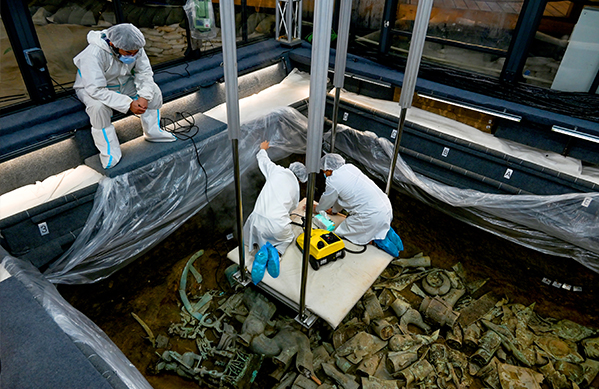Sanxingdui tells story of cultural exchange

Archaeologists work in Pit No.8 at the Sanxingdui site on June 1 Photo: CFP
Civilizations cannot grow in isolation. They must form and develop through cultural exchanges and mutual learning. The Sanxingdui Ruins site dates to the Xia (c. 21st–16th century BCE), Shang (c. 16th–11th century BCE), and Zhou (c. 1046–256 BCE) dynasties. Particularly interesting is that the period of ancient Shu civilization at its height, or the period the Sanxingdui sacrificial pits dated to, was synchronized with the Central Plain civilization’s prime (the middle and late Shang Dynasty).
Current findings suggest that the Shang Dynasty elements unearthed from the Sanxingdui sacrificial pits were not anomalies. As early as the late Neolithic Age, more than 4,000 years ago, the culture of the middle and lower reaches of the Yangtze River spread westward and entered the Chengdu Plain in present-day Sichuan Province. A large number of artifacts dated from the period of the Erlitou Culture (c. 21st–16th century BCE) to the early Shang Dynasty, which were similar to the typical artifacts of the Xia Dynasty, were unearthed from the Sanxingdui site. They reflected the extraordinary connection between the Sanxingdui site and the Central Plain. The unearthed Shang-style bronzeware and jade ware in the Sanxingdui sacrificial pits also served as important evidence of the communication between the upper classes of Sanxingdui and the Central Plain.
The discoveries from successive archaeological excavations in Henan, Hubei, and Sichuan provinces, as well as Chongqing Municipality and other places in China, outline a clear route of cultural communication. This route started from Wuhan in Hubei Province, headed west along the Yangtze River, turned to the Minjiang River at Yibin City in Sichuan Province, and finally took root in the Chengdu Plain.
Archaeologists also discovered elements of the Longshan Culture (c. 2500–2000 BCE) and Qijia Culture (c. 2000–1900 BCE) at the Sanxingdui Ruins site and the sacrificial pits. However, compared with the cultural influence of the Central Plain and the middle and lower reaches of the Yangtze River, the influences of the other cultures were obviously weaker upon the Sanxingdui site, especially the sacrificial pits.
There is always exchange and mutual learning in the communication of culture, and it is not a one-way communication. During its cultural peak, Sanxingdui culture also expanded extensively. Cultural relics related to this period have been found in Hubei, Guizhou, Yunnan, and Sichuan provinces. Studies show that the cultural influence of Sanxingdui in the southwest reached as far as Hanoi, Vietnam. Related remains unearthed at Vietnam included jade ware, pottery, and stone tools, and these artifacts are of the highest rank, which suggests that there used to be close connections between Sanxingdui and Vietnam. It also reminds us that there may be more important sites still to be discovered between Sanxingdui and Vietnam, which are thousands of miles away from each other.
In Henan Province, the core area of the Shang culture that had the greatest impact on Sanxingdui, numerous sites have been excavated over the years, but no clues of the cultural influence of the Chengdu Plain have ever been confirmed. A possible explanation is that compared with the Shang culture, the Shu culture was in a lower position. Perhaps future archaeological excavations and research will answer our questions.
Gao Dalun is a research fellow of the Sichuan Provincial Cultural Relics and Archaeology Research Institute.
Edited by REN GUANHONG

 PRINT
PRINT CLOSE
CLOSE